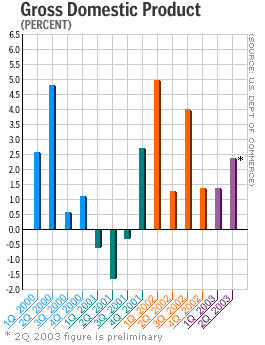NEW YORK (CNN/Money) - The pace of U.S. economic growth improved in the second quarter of 2003, the government said Thursday, coming in much stronger than economists expected.
Gross domestic product (GDP), the broadest measure of economic activity, grew at a 2.4 percent annual rate in the quarter after growing at a sluggish 1.4 percent rate in the first quarter, the Commerce Department reported. Economists, on average, expected GDP growth of 1.5 percent, according to a Reuters poll.

It was the strongest showing for GDP since a 4 percent growth rate in the third quarter of 2002.
"The economy truly does look to be on the mend," said Joel Naroff, president and chief economist at Naroff Economic Advisors in Holland, Pa. "While the 2.4 percent rise in GDP during the second quarter wasn't spectacular, the details were heartening."
The report will be revised at least twice in the coming months.
The news, together with a Labor Department report showing another week of falling claims for unemployment benefits, helped boost U.S. stock prices in midday trading. Treasury bond prices reversed earlier gains.
Most of the second-quarter increase in GDP was due to a 3.3 percent pace in the growth of consumer spending, which makes up more than two-thirds of the total economy.
Also supporting GDP growth was a 25.1 percent annualized pace in the growth of federal government spending, the fastest rate since 30.3 percent in the first quarter of 1967. That growth rate was mostly due to a 44.1 percent annualized pace of defense spending growth, the fastest pace since a 110 percent rate in the third quarter of 1951.
The defense spending was concentrated on prosecuting the U.S.-led war with Iraq. According to most economists, the buildup to that war sank consumer confidence and spending and caused businesses to delay plans for investment and hiring.
Most economists thought the effects of the war, along with an expanding trade gap, would sink the GDP growth rate well below 2 percent in the quarter, but stronger consumer and business spending helped dash those expectations.
Consumers have continued to spend money relentlessly the past few years, despite a recession and terror attacks in 2001, corporate accounting scandals in 2002, a war in 2003 and a bear market in stocks that began in 2000.
Businesses, contrary to popular belief, have been spending money in the past year or so, but much of that spending has been dedicated to replacing worn-out equipment; there have been few signs of the kind of robust business expansion that might lead to greater hiring.
| Related stories
|

|
|
|
|
As a result, the "recovery" from the recession of 2001 has been notable for being the longest job-market slump since World War II. But the second-quarter GDP report showed the strongest business spending in more than three years, raising hopes that a labor-market turnaround could be next.
Nonresidential fixed investment, a proxy for business spending, rose at a 6.6 percent rate in the quarter, the strongest pace since the second quarter of 2000.
Investment in equipment and software rose at a 7.5 percent pace, the strongest pace since 10.9 percent in the second quarter of 2000.
And business investment in structures rose at a 4.8 percent rate, the first gain since a 3.6 percent rise in the fourth quarter of 2000.
But not all was rosy with the report -- though the change in business inventories was decidedly negative in the quarter, raising the prospect of increased production in the future, the inventory number is volatile, and many companies have learned in recent years to work with "just-in-time" practices, meaning there's no guarantee these inventories will need to be replenished.
What's more, a big motivating factor for the jump in consumer spending was a surge in the pace of automobile sales, driven by dealer incentives. Those incentives can't be extended forever without bankrupting automakers, and growth in sales of non-durable goods and services -- the biggest components of consumer spending -- was tepid.
"This is a better-than-expected report, but not one that gives you full confidence that this is an economy ready to spring ahead," said Josh Bivens, economist at the Economic Policy Institute, a Washington research group.

|

